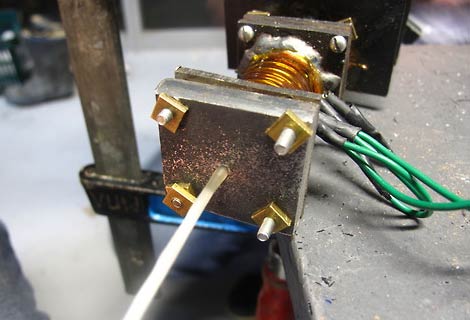The old saying, “garbage in, garbage out” may need to be re-evaluated. Students at Victoria University of Wellington are developing a machine that recycles old milk jugs, extruding an HDPE plastic filament that can then be fed into a MakerBot for 3D printing.
The process involves grinding the plastic into small pieces, then pressing these through a heater and extruder plate to produce a continuous bead of the proper diameter for the MakerBot. Nichrome wire — the stuff of hair dryers and toasters — forms the heating element, and this must be regulated within a specific temperature range for different plastics. The initial grinder design is hand-cranked, but they are working toward a fully automated system. It appears that the machine could also recycle old MakerBot output, provided the grinder has sufficient torque.
















the big question is, how much does this weaken the plastic. it’d be interesting if they printed objects with this and compared strength with fresher filament.
also, I am really not a fan of those slide-show picture thingies :/
Bravo! I’m very impressed with this. I wish we’d done things like this at university.
Is the ‘digest’ the fancy new way of saying ‘melt’? Neat-o.
As if we currently don’t go through our neighbor’s trash looking for maker stuff?
Reminds me of http://en.wikipedia.org/wiki/Transmetropolitan where the middle class gather trash from the street every morning to feed their atomic makers.
What about the prepwork involed with cleaning out any residue?
This is a great idea. I think nave.notnik is right though to bring up degradation of the plastic. If I’m not mistaken, plastic cannot be infinitely recycled like aluminum can because it weakens a little each time through.
If you mix fresh plastic with recycled, you can stay fairly close to the original strength.
Where I work, we use custom made plastic posts that contain a percentage of remolded content(the rejects and sprues from the previous batch). As long as we put in at least 90% fresh, it meets spec. Although bad mixing will sometimes let the same plastic through multiple times and then we have to start over with 100% new plastic.
If they bought HDPE in granular form instead of filament, then they could mix it with the recycled as they melt it. They might even be able to get the powdered HDPE for cheaper than filament.
Yes, you have to definitly control your regrind percentage. Every time you remelt the plastic you break some of the long polymer chains into shorter chains, which do not entangled as well as the longer chains, leading to a weaker product. I would also look into the properties of the plastic you are using. ( delrin likes to thermally decompose with some very unfriendly results.)
Hell yes!
I have been following RepRap and MakerBot for a long time now. I have seriously considered buying or making one. The major reason that I have not done so is I know that I would go wild making things with it, and most likely would go broke buying HDPE to feed the friendly monster.
This changes things considerably. Being able to effectively recycle HDPE so it is usable by a 3D printer is something that I have thought about in passing, but have never pursued. This would drastically reduce the cost of using one of these machines, and most likely make them more affordable to a wider range of people.
Keep up the great work!
Steve
vuw represent :-) – vuw alumni
But… what of the refund of the deposit on all those plastic milk cartons? Is the milk carton composed of more than $0.25 worth of plastic?
They offer you a DEPOSIT on milk jugs?!
Where is that happening?
Wow, I wish they offered $0.25 per milk container where I live.
KnightFire: We don’t get that in NZ.
With regard to the strength: Having a cheap source of plastic for jobs where the extra strength is not required (cellphone stand, casting moulds, models, etc.) would be very useful.
whoever said you depolymerize the plastic is a fucktard. For polyethylene, the depolymerization point is about 450 degrees F above the melting point, FUCKTARD!
Language Timothy. You sound like an a$$hole speaking to people like that.
Gee, Ben – first of all, “break[ing] some of the long polymer chains into shorter chains” does not equal depolymerization, and happens at lower temperatures (and also mechanically during the grinding process) than for HDPE. As for “Delrin” (DuPont’s trade name for Polyoxymethylene or POM), the melting point is much lower than for HDPE (the product in the OP) or PET (the product you’re citing). While depolymerization will be extensive at 450°F above the melting point (at standard pressure in the absence of catalysts), it begins far below that temperature.
@John, pure aluminium can theoretically be recycled infinitely, however in practice a lot of aluminium is alloyed with other metals. For example, most aluminium drink cans use one alloy for the top, and another for the walls. When melted down together, the resulting material is a downgrade (so it is downcycling, not recycling). It would require significantly more energy to separate drink cans back into their constituent metals for true recycling.